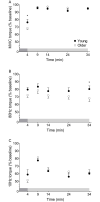Muscle architecture, voluntary activation, and low-frequency fatigue do not explain the greater fatigue of older compared with young women during high-velocity contractions
- PMID: 33141870
- PMCID: PMC7608879
- DOI: 10.1371/journal.pone.0234217
Muscle architecture, voluntary activation, and low-frequency fatigue do not explain the greater fatigue of older compared with young women during high-velocity contractions
Abstract
Although high-velocity contractions elicit greater muscle fatigue in older than young adults, the cause of this difference is unclear. We examined the potential roles of resting muscle architecture and baseline contractile properties, as well as changes in voluntary activation and low-frequency fatigue in response to high-velocity knee extensor work. Vastus lateralis muscle architecture was determined in quiescent muscle by ultrasonography in 8 young (23.4±1.8 yrs) and 8 older women (69.6±1.1). Maximal voluntary dynamic (MVDC) and isometric (MVIC), and stimulated (80Hz and 10Hz, 500ms) isometric contractions were performed before and immediately after 120 MVDCs (240°.s-1, one every 2s). Architecture variables did not differ between groups (p≥0.209), but the half-time of torque relaxation (T1/2) was longer in older than young women at baseline (151.9±6.0 vs. 118.8±4.4 ms, respectively, p = 0.001). Older women fatigued more than young (to 33.6±4.7% vs. 55.2±4.2% initial torque, respectively; p = 0.004), with no evidence of voluntary activation failure (ΔMVIC:80Hz torque) in either group (p≥0.317). Low-frequency fatigue (Δ10:80Hz torque) occurred in both groups (p<0.001), as did slowing of T1/2 (p = 0.001), with no differences between groups. Baseline T1/2 was inversely associated with fatigue in older (r2 = 0.584, p = 0.045), but not young women (r2 = 0.147, p = 0.348). These results indicate that differences in muscle architecture, voluntary activation, and low-frequency fatigue do not explain the greater fatigue of older compared with young women during high-velocity contractions. The inverse association between baseline T1/2 and fatigue in older women suggests that factors related to slower muscle contractile properties may be protective against fatigue during fast, repetitive contractions in aging.
Conflict of interest statement
The authors have declared that no competing interests exist.
Figures






Similar articles
-
Effects of older age on contraction-induced intramyocellular acidosis and inorganic phosphate accumulation in vivo: A systematic review and meta-analysis.PLoS One. 2024 Sep 25;19(9):e0308336. doi: 10.1371/journal.pone.0308336. eCollection 2024. PLoS One. 2024. PMID: 39321147 Free PMC article.
-
Knee extensor fatigue resistance of young and older men and women performing sustained and brief intermittent isometric contractions.Muscle Nerve. 2014 Sep;50(3):393-400. doi: 10.1002/mus.24174. Muscle Nerve. 2014. PMID: 24408784
-
Fatigability and recovery of arm muscles with advanced age for dynamic and isometric contractions.Exp Gerontol. 2013 Feb;48(2):259-68. doi: 10.1016/j.exger.2012.10.006. Epub 2012 Oct 26. Exp Gerontol. 2013. PMID: 23103238 Free PMC article.
-
Age-related fatigue resistance in the knee extensor muscles is specific to contraction mode.Muscle Nerve. 2009 May;39(5):692-702. doi: 10.1002/mus.21278. Muscle Nerve. 2009. PMID: 19347926 Free PMC article.
-
Sex differences in fatigability of dynamic contractions.Exp Physiol. 2016 Feb;101(2):250-5. doi: 10.1113/EP085370. Epub 2015 Nov 17. Exp Physiol. 2016. PMID: 26440505 Free PMC article. Review.
Cited by
-
Effects of older age on contraction-induced intramyocellular acidosis and inorganic phosphate accumulation in vivo: A systematic review and meta-analysis.PLoS One. 2024 Sep 25;19(9):e0308336. doi: 10.1371/journal.pone.0308336. eCollection 2024. PLoS One. 2024. PMID: 39321147 Free PMC article.
-
Impact of low-load resistance exercise with and without blood flow restriction on muscle strength, endurance, and oxidative capacity: A pilot study.Physiol Rep. 2024 Jun;12(12):e16041. doi: 10.14814/phy2.16041. Physiol Rep. 2024. PMID: 38888154 Free PMC article.
References
Publication types
MeSH terms
LinkOut - more resources
Full Text Sources
Medical

